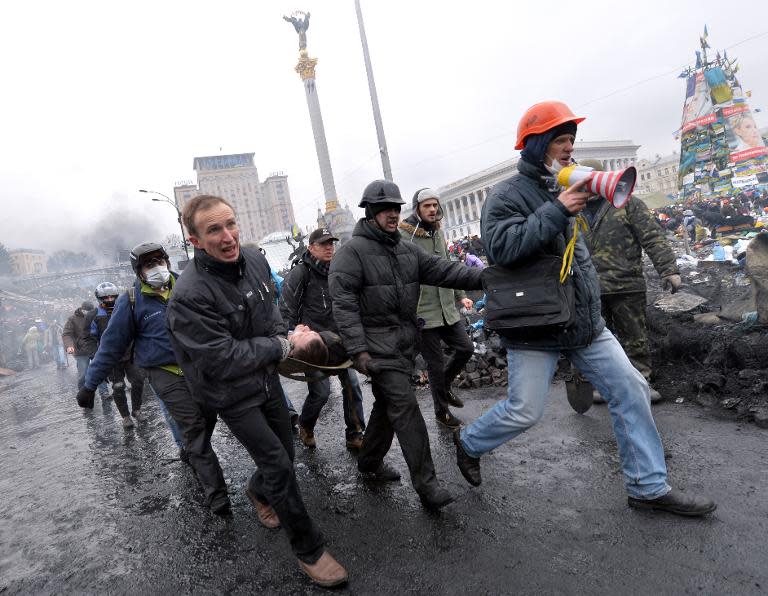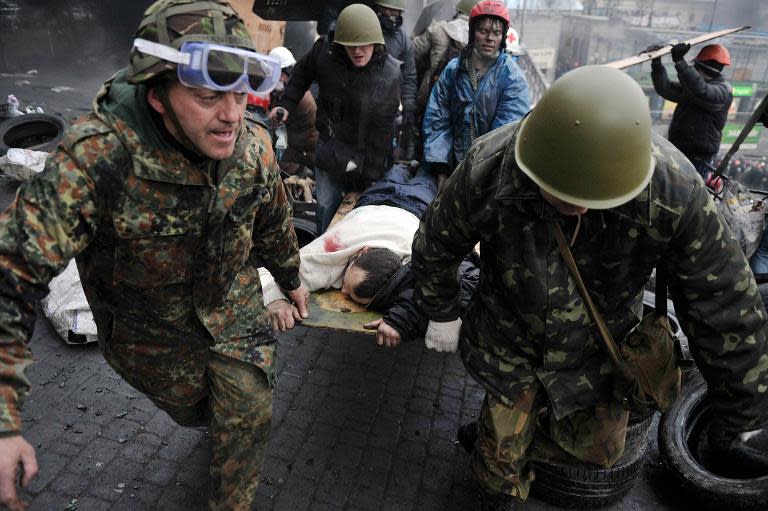Blood and tears on Kiev's Independence Square
As fighting rages all around him on Kiev's Independence Square, a volunteer medic tears open a young protester's bloodstained T-shirt and desperately pumps his chest as the patient's grey face stares into the sky. Nearby, protesters scream wildly for people to clear a path for a stretcher carrying a man's covered body. A helmet lies on his chest. His arm dangles down lifelessly. Dazed demonstrators move out of the way, some crossing themselves, as smoke from burning barricades and car tyres billows into the air around them, like scenes from a war film. It is the deadliest day yet in three months of anti-government protests in Ukraine and Kiev's Independence Square, known as the Maidan, is Ground Zero. Riot police fire salvos of rubber bullets at anti-government protesters who hurl back Molotov cocktails and stones, determined to take back full control of the square, the epicentre of the opposition-led protest movement. Overlooking the square is the towering Soviet-era Ukraina Hotel, home to many of the foreign reporters covering Ukraine's worst unrest since independence. A flag with a red cross hastily strung from the building signals that it is now also a makeshift clinic and morgue. Inside, volunteer health workers have taken over the lobby. Seven bodies covered with white sheets are lined up on the marble floor in front of the reception desk. "They were shot in the head or in the heart by live bullets, not by rubber ones," says volunteer first aid worker Natalia, pointing to a bloodstained bulletproof vest lying discarded on the hotel floor, with a hole shot through it. Protesters and police have both accused each other of using live ammunition in the clashes, with the interior ministry insisting security forces only fired in self-defence. According to the volunteer medics, more than 60 protesters died from gunshot wounds on Thursday. Back on the square, protesters manning the barricades show an AFP reporter spent cartridge shells, and metal shields pierced with what look like bullet holes. A short distance away, riot officers can be heard firing warning shots. "Everything started around 8:00 am, when riot police tried to set fire to the Conservatory," says protester Andrei, in reference to a concert hall occupied by the opposition. "We pushed forward to repel them and they opened up on us with Kalashnikovs and sniper fire." - Chaos too much to bear - Above the turmoil on the square, loudspeakers relay the positions of suspected sharp shooters spotted on the roofs and at the windows of nearby buildings. For some, the chaos is too much to bear. Struggling to take in the carnage around him, a young man sits hunched over on the pavement, sobbing. Nearby, a middle-aged woman weeps openly and is comforted by her husband. But for most, there is little time to waste, with every spare moment being used to reinforce barricades and stockpile Molotov cocktails. In one area of the square, hundreds of demonstrators -- including old men and young women -- stand in long human chains passing paving stones to the frontlines, as men clad in camouflage gear drag everything from telephone booths to rubbish skips towards the barriers. From a podium in the middle of the square chants of "Glory to Ukraine" ring out, lifting the protesters' spirits.



